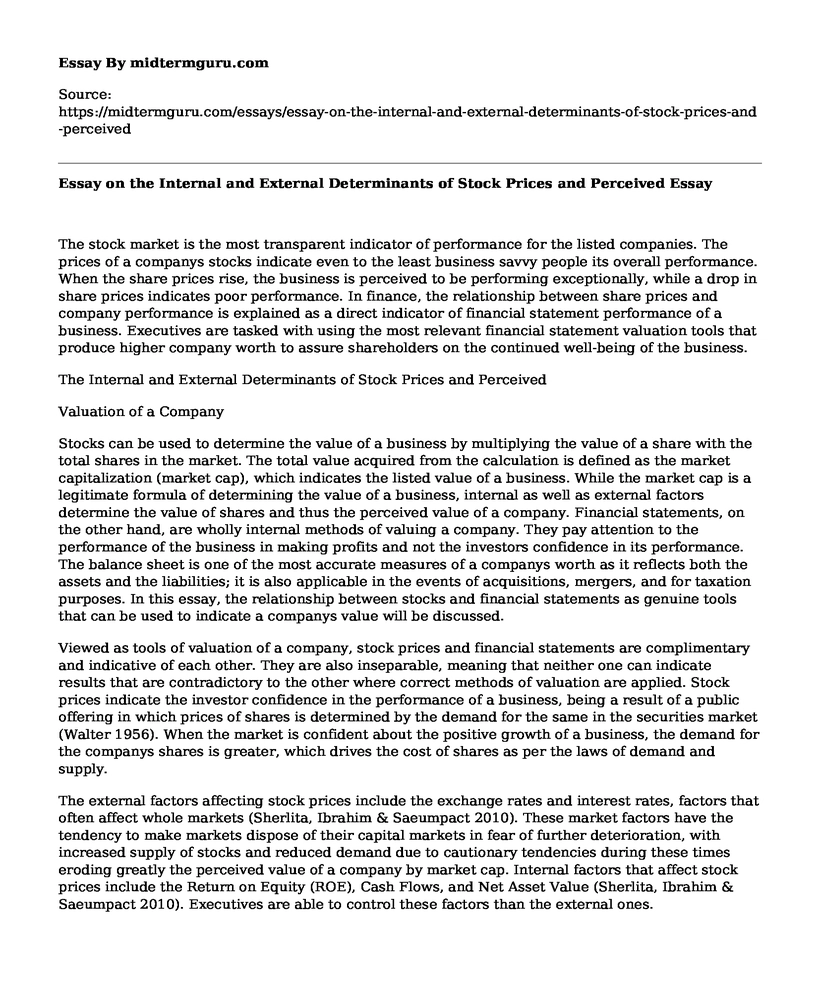The stock market is the most transparent indicator of performance for the listed companies. The prices of a companys stocks indicate even to the least business savvy people its overall performance. When the share prices rise, the business is perceived to be performing exceptionally, while a drop in share prices indicates poor performance. In finance, the relationship between share prices and company performance is explained as a direct indicator of financial statement performance of a business. Executives are tasked with using the most relevant financial statement valuation tools that produce higher company worth to assure shareholders on the continued well-being of the business.
The Internal and External Determinants of Stock Prices and Perceived
Valuation of a Company
Stocks can be used to determine the value of a business by multiplying the value of a share with the total shares in the market. The total value acquired from the calculation is defined as the market capitalization (market cap), which indicates the listed value of a business. While the market cap is a legitimate formula of determining the value of a business, internal as well as external factors determine the value of shares and thus the perceived value of a company. Financial statements, on the other hand, are wholly internal methods of valuing a company. They pay attention to the performance of the business in making profits and not the investors confidence in its performance. The balance sheet is one of the most accurate measures of a companys worth as it reflects both the assets and the liabilities; it is also applicable in the events of acquisitions, mergers, and for taxation purposes. In this essay, the relationship between stocks and financial statements as genuine tools that can be used to indicate a companys value will be discussed.
Viewed as tools of valuation of a company, stock prices and financial statements are complimentary and indicative of each other. They are also inseparable, meaning that neither one can indicate results that are contradictory to the other where correct methods of valuation are applied. Stock prices indicate the investor confidence in the performance of a business, being a result of a public offering in which prices of shares is determined by the demand for the same in the securities market (Walter 1956). When the market is confident about the positive growth of a business, the demand for the companys shares is greater, which drives the cost of shares as per the laws of demand and supply.
The external factors affecting stock prices include the exchange rates and interest rates, factors that often affect whole markets (Sherlita, Ibrahim & Saeumpact 2010). These market factors have the tendency to make markets dispose of their capital markets in fear of further deterioration, with increased supply of stocks and reduced demand due to cautionary tendencies during these times eroding greatly the perceived value of a company by market cap. Internal factors that affect stock prices include the Return on Equity (ROE), Cash Flows, and Net Asset Value (Sherlita, Ibrahim & Saeumpact 2010). Executives are able to control these factors than the external ones.
As indicated above, the financial statements determine in a big way the prices of a companys shares as well as being the most authoritative tool for its valuation. The balance sheet is the most prominent of these tools, and it is broken down into four other methods namely; book value, adjusted book value, liquidation value, and sustainable methods. For the purpose of this easy, the book value and adjusted book value shall be examined. The book value demotes the equity of shareholders that is stated in the balance sheet, while the adjusted book value goes further and matches the liabilities and the assets to their current market values (Fernandez 2007). After all balance sheet calculations are performed, the profits are determined and the individual share allocation determined in the form of bonuses. Bonuses earned from stocks have the greatest impact on the market demand for a companys shares as all investors prefer shares that earn good returns.
Executives can therefore manipulate the balance sheet methods and account for assets and liabilities in ways that boost the companys perceived profitability and value. The perception of great performance increases investor confidence in a company and boosts its stock prices, thus the market cap is increased. Other methods include building the stature of the company by marketing activities, which also raises the demand of a companys shares as well as its valuation. Higher-valued companies are more likely to continue making profits due to increased circulation of investor money, which assures shareholders interests to benefit from their investments.
References
Walter J. E. (1956). Dividend Policies and Common Stock Prices, The Journal of Finance, Vol. 11, Issue 1, pp. 2941, DOI: 10.1111/j.1540-6261.1956.tb00684.x
Fernandez P. (2007). Valuation Methods and Shareholder Value Creation: San Diego, Academic Press
Sherlita E., Ibrahim M. & Saeumpact T. L. (2010). Influence of Internal and External Factors on Stock Price, Malaysia-Indonesia Conference on Economics, Management and Accounting, pp. 618-624.
Cite this page
Essay on the Internal and External Determinants of Stock Prices and Perceived. (2021, Jul 05). Retrieved from https://midtermguru.com/essays/essay-on-the-internal-and-external-determinants-of-stock-prices-and-perceived
If you are the original author of this essay and no longer wish to have it published on the midtermguru.com website, please click below to request its removal:
- Essay on the Implications of Capital Markets
- Questions and Problems on Company's Gross Profit
- Essay on Effects of Inadequate Medical Insurance
- Paper Example on Pros and Cons of National Health Insurance
- Paper Example on Mexican Economy
- Blockchain & Bitcoin: Revolutionizing Global Commerce & Finance - Essay Sample
- Trump's Tax Reforms: Promises Fulfilled After 3 Decades - Essay Sample







